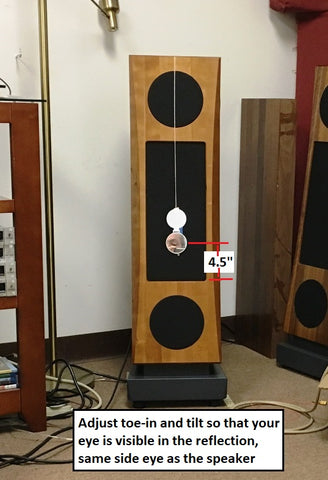Back-tilt for the Valentina
The purpose of the Valentina's back-tilt is to present the sound from all drivers in phase, that is, time-aligned, as nearly as possible. This not only provides the best image focus, but is also responsible for presenting the image well above the tops of the speakers.
The back-tilt is adjustable by adjusting the feet. The correct setting depends on your distance from each speaker and your ear height from the floor.
They are delivered set for an 8' [2.4m] ear distance and 38" [1m] ear height. If this is incorrect for your situation, there are two ways to get the angle just right.
1) Hang a small mirror against the front of the speaker. Have some pieces of wood or thin paperback books or what-not to temporarily prop one of the speakers up while seeking the best angle. The following snapshot illustrates the trick:

2) If you have an RTA or impulse response-based frequency response measurement setup, you can simply place the microphone at each ear position (the top octave is affected by the difference in left-right ear position), and adjust the angle of each speaker for flattest response.
Tilt explained
After the following brief explanation is a series of diagrams that indicate what is going on with tilt:
There are two electrostatic transducer panels, one above the other. They are tilted back from where they meet with a 6° angle between them. This is to spread the sound into a taller listening window than would otherwise occur. Without this angle, the tall height of the pair of panels would create about a 1" [2.5 cm] tall listening window. On the other hand, a wider angle creates too much treble droop on axis.
The red line is the axis of the upper panel, the green line is the axis of the lower panel, and the yellow line is the central axis, e.g., perpendicular to the middle of the baffle. (The blue and gray lines have to do with making an equilateral triangle, which is beside the present point.) The response plots were taken in my office, so please excuse the minor ripples.
Not enough tilt
The first diagram illustrates the situation when the speaker is aimed exactly at the ears. In this case, each panel is aimed 3° above or below straight at the ears. This causes some response droop in the top octave, but otherwise the curve is pretty flat.
Because the droop is simply due to aperture effect, there is no impact on phase, so if you are someone without much hearing sensitivity above 15 kHz, there would be little point in further adjustment if the speakers arrived this way, which they generally won't, because we ship them with a typically ideal amount of front foot elevation.

Ideal tilt
The next diagram illustrates the ideal tilt angle for the 38" [97 cm] ear height at 9' [275 cm] distance shown. This is where the aim is midway between having either the central axis or the lower panel aimed directly at the ears, which is how the speakers are shipped.
The gentle roll-off in the treble response is a deliberate feature of the active version's equalization. It creates a more natural presentation than an absolutely flat response, considering the usual microphone placements when making recordings. The passive version rolls up a bit in the treble, which is corrected by reducing the toe-in.

Too much tilt
The last diagram illustrates what happens when the lower panel is aimed directly at the ears. Interference effects between the two panels causes a mid-treble dip, and the on-axis response of the lower panel causes an upper treble rise.
Of course, these deviations are still well within what is generally accepted as an adequate ±3 dB response flatness, and the narrow bandwidth smoothness remains impeccable (no peakiness). While the effect of this degree of tilt will be undetectable to most people, just possibly making the speakers sound slightly dark, I consider it worth avoiding, nonetheless.

